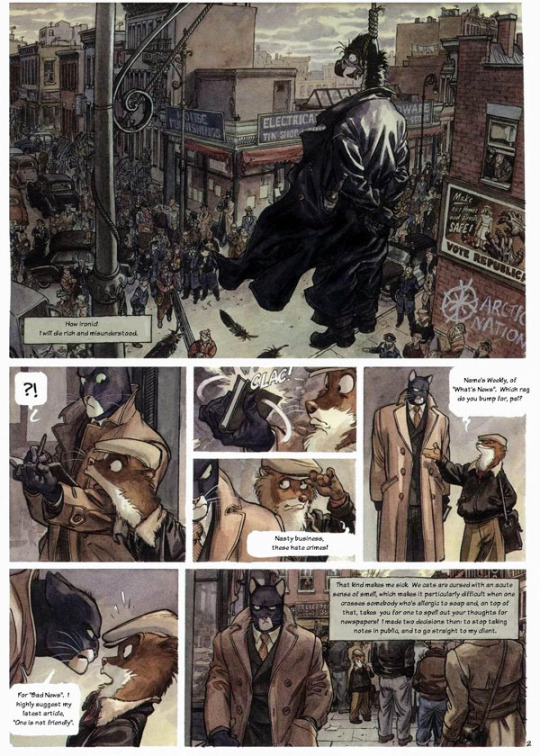


In light of the recent Comic-Con announcements and Blacksad receiving yet another Eisner nomination, I thought now might be a good time to bring to bear a piece I’ve been thinking about for quite some time. Blacksad is a very popular noir comic featuring the titular detective John Blacksad. Throughout the series of comics, John Blacksad solves crime, knocks some skulls together, and makes friendly with the ladies in the classic noir style. But the most striking feature of Blacksad is its use of anthropomorphic characters – the book’s namesake detective is a black tomcat with a white muzzle.
In “Artic Nation,” John Blacksad is hired by a teacher, Ms. Grey, to find a student who has been kidnapped. The story takes place in a small town nicknamed “The Line” in what is essentially the American South. Within this story, Canales and Guarnido use the trappings of the Jim Crow South to tell a story of race and revenge. A white supremacist hate group called the Arctic Nation commits heinous acts of murder and torture throughout the story, the source of societal devolution and fear. The second page of the story starts with a lynching. In order to find the girl, Blacksad goes through twists and turns, throws a few punches, shoots some racists, and uncovers the truth behind the girl’s kidnapping.
This is furry people comics in the mainstream, which is unusual, but the use of anthropomorphic animal characters is as ancient a storytelling tool there is, and over time certain types of animals have been awarded a stereotypical set of features. Some of which come from our understanding of the animal and some are just how the animal looks; i.e. the corvid is seen as greedy or a hoarder (fairly accurate) and the owl is often portrayed as a wise man (when in fact owls as a bird are good hunters, but are pretty dumb). Blacksad takes this a step further, and codes characters as certain species not just to assign stereotypical personality traits, but also to represent race. This coding can be troubling, especially in the “Arctic Nation” issue which appears collected in the first English volume of Blacksad.
The plot is focused on the Arctic Nation, and its counterpart, the Black Claws. The Arctic Nation is a supremacist group made up mostly of men of power – its leader the police chief Karup, a polar bear, has a sword owned by Robert E. Lee hanging in his office and proudly displays it to Blacksad at the beginning of the book. The Black Claws are shown to be another nefarious group after the introduction of the Arctic Nation. Clearly these two groups are thinly veiled KKK and the Black Panthers. But what I find interesting is the choice of animals in either group; white animals tend to be apex predators – lions, tigers, and polar bears, oh my! But black animals are coded as beasts of burden, crows, and primates (monkeys, gorillas, orangutans). That alone makes me stop and scratch my head – stated plainly, many of the black men in this book are portrayed as apes.
Blacksad’s racial coding doesn’t just exist in “Arctic Nation.” In the first story, “Somewhere Within The Shadows,” both primates and reptiles appear to be coded/caricatured as male people of color, and these characters are not shown in a positive light. It’s clear that in Blacksad there are “bad animals,” reptiles being one of those groups.
Use of animal species to represent race or creed isn’t necessarily a new concept to Blacksad. Famously, Art Spiegelman’s Maus uses various animal species to represent different races in the story of his father’s time as a Polish Jew during WWII and Nazi Germany and as a Holocaust survivor. But the use is different here; Maus lumps each race together in a way that shows the absurdity of the notion; the animal metaphor in Maus is designed to self-destruct over time. But even Maus, with its completely different focus, has been criticized as dehumanizing.
I have other qualms about Blacksad that aren’t really that intricately linked with its ugly portrayal of race. The length to which female characters are anthropomorphized in Blacksad compared to their male counterparts is suspect (male-gaze driven at the least, and often gross). Women are more humans wearing cat ears and snouts whereas men are polar bears in business suits. There’s a laziness to the worldbuilding here – animal species appears to be chosen basically at random, minus the racial concerns I’ve already discussed, and the conflict within the stories doesn’t seem to follow any logical line (cats vs. dogs, etc.). The internal logic doesn’t make a whole lot of sense in general (how do a deer and a polar bear have a pair of fraternal twin girls, one of which is a deer and the other a polar bear?) There’s also the appropriation of Allen Ginsberg’s poetry by a murderous sociopath; take it all as it is.
Scads have been written about how pretty Blacksad is, and I can’t deny that – clearly the art is a major focus point for the people who love Blacksad. But these comics are not smartly written, more Americana than American (something to be expected, perhaps, given their European origin). Without strength in other areas, Blacksad’s troubling features become the only things that are memorable. With the way Canales and Guarnido develop their characters and assign race on top of fur, you’ve got a comic that is simultaneously gross and boring – despite the pretty pictures.

One response to “Thoughts on Blacksad and Its Portrayal of Race”
[…] the type of factor that actually shouldn’t have to be said. (I’ll additionally observe that portrayals of race are apparently an issue in the comics, […]